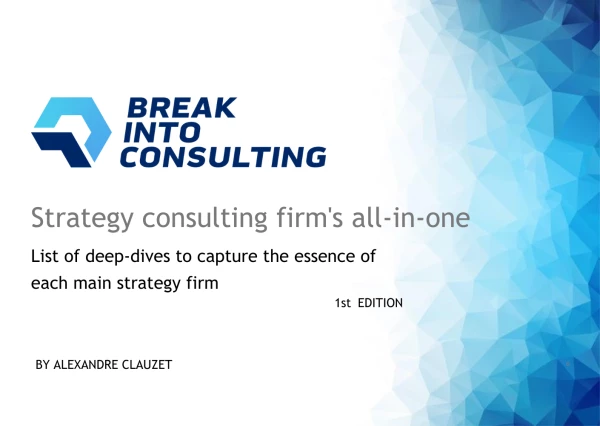Hello,
I struggle with understanding and gaining insights from exhibits. I would greatly appreciate any tips on how I can sharpen my skills on analyzing and gaining insights from exhibits?
Really appreciate yout time and advice.
Hello,
I struggle with understanding and gaining insights from exhibits. I would greatly appreciate any tips on how I can sharpen my skills on analyzing and gaining insights from exhibits?
Really appreciate yout time and advice.


Good question - I think a lot of people try too hard to impress the interviewer here and therefore make mistakes.
You are being tested for three things:
1) Can you read a chart?
2) Can you draw information that is relevant to the case
3) Can you use the information to suggest various ideas (depends on the question)
You'll notice that as you move from #1-3, you move from a more closed question to a more open-ended question.
Therefore - this is the key:
1) Start with the simple task of demonstrating you know how to read a chart by reading the title, the axes, and what are the main trends or pieces of information in the chart
2) Then draw out some information that you can discuss with the interviewer
3) Only then should you pause and try to come up with a structured set of creative ideas
If you go straight to #3, you are risking going down the wrong path and failing to demonstrate #1. Also, would you ever go straight to #3 in a real-life consulting engagement? Align with the team on #1 first! Just don't spend too much time on #1.
Finally, don't forget the question that was asked! Sometimes the interviewer will say, "The client brought you this data. What does this imply?" in which case it's much more open ended. But sometimes the interviewer will make it easier for you by asking, "What does this chart tell you about the proposed strategy?"
Helpful? Let me know what you think!


Hi,
Several things about analyzing the tables / charts:
Sources to learn from (prioritized):
Good luck!

Hello!
I used to struggle with the same thing ;)
I would strongly recomment you practice it with the Integrated Reasoning part of the GMAT exam.
There are free exams in the internet that you can use for practice (the one of LBS MBA page, Verits prep, as well as some free trials for courses such as the one of The Economist (https://gmat.economist.com/)
Furthermore, you can leverage the MBB tests (https://www.myconsultingoffer.org/case-study-interview-prep/bcg-online/, https://www.psychometricinstitute.co.uk/Free-Aptitude-Tests.asp, and many others)
Hope it helps!

Hello,
To interpret a graph or chart, read the title, look at the key, read the labels. Then study the graph to understand what it shows.
Read the title of the graph or chart. The title tells what information is being displayed.
Look at the key, which typically is in a box next to the graph or chart. It will explain symbols and colors used in the graph or chart
Read the labels of the graph or chart. The labels tell you what variables or parameters are being displayed.
Draw conclusions based on the data. You can reach conclusions faster with graphs than you can using a data table or a written description of the data.
To practice all this bullets GMAT Integrated Reasoning questions helps you a lot!
Was it helpful for you?
GB

Hi there,
I recommend the following:
Best Rote Practice
Rocket Blocks: https://www.rocketblocks.me/
Best Practice Strategy
1) Read the Economist (especially the daily graph and Financial Time frequently
https://www.economist.com/graphic-detail/2020/05/29/america-first
2) Ask case partners to focus particularly on your chart-reading skills (i.e. by providing you with cases with many charts) - Bain and Deloitte cases tend to be chart heavy
Graph Interpretation Tips
1) Read the title - and understand it
2) Read the legends - and understand them
3) Remind yourself of the objective / hypothesis in the case, to see where this might fit
4) Find the differences - where does the line graph plummet or spike? Which column is a lot smaller or bigger than the others? Where does change occur? The differences are what matter
5) Talk outloud while interpreting - first, it helps you think and process your thoughts, second, it lets the interviewer provide guidance and course correct if needed.

I agree with Ian - go to rocketblocks and practice it. It is a learned skill that gets much easier with practice.

Hi, in addition to the good points of other coaches I recommend reading the related book of Cosentino about chart reading
Best
Antonello












